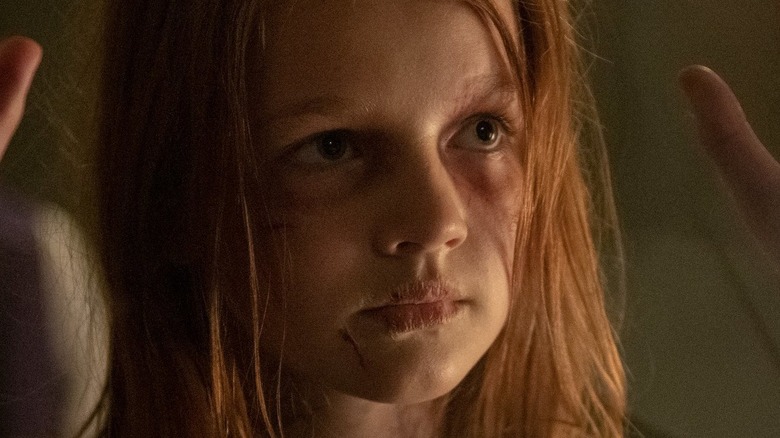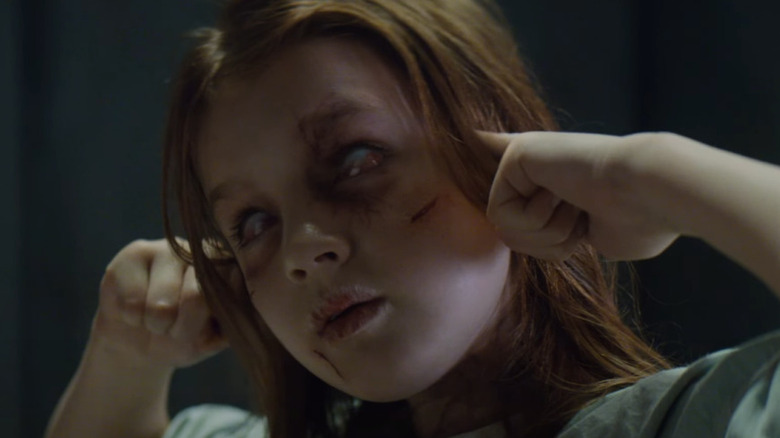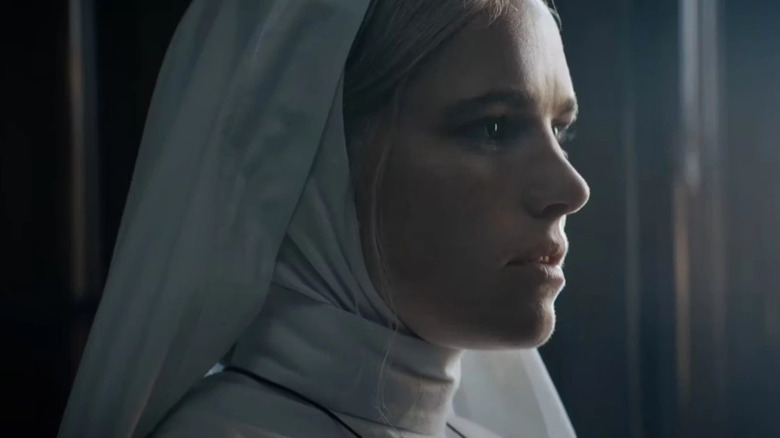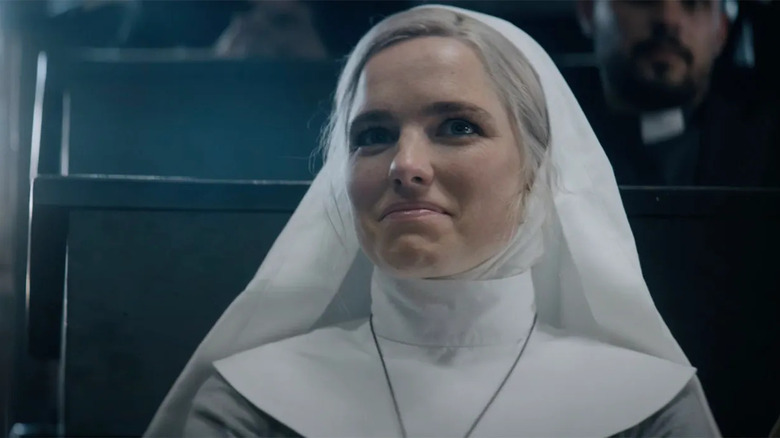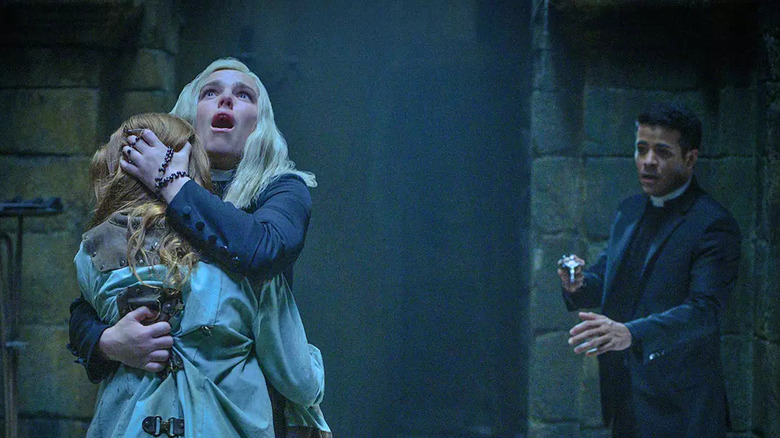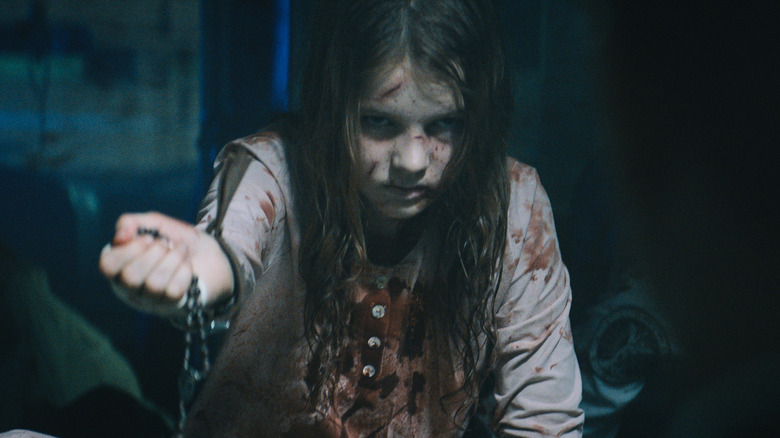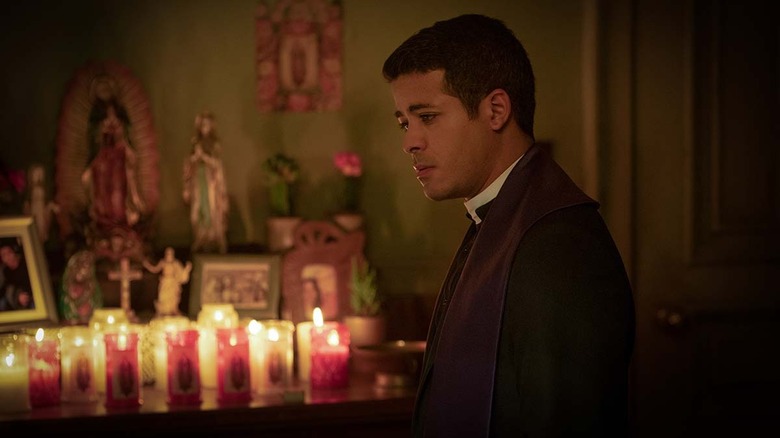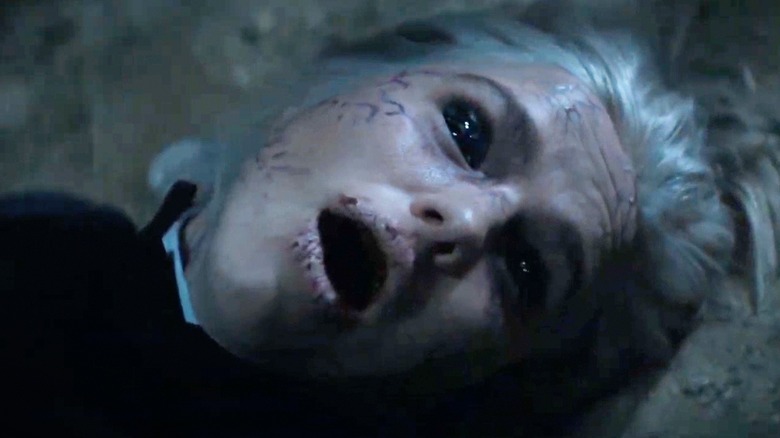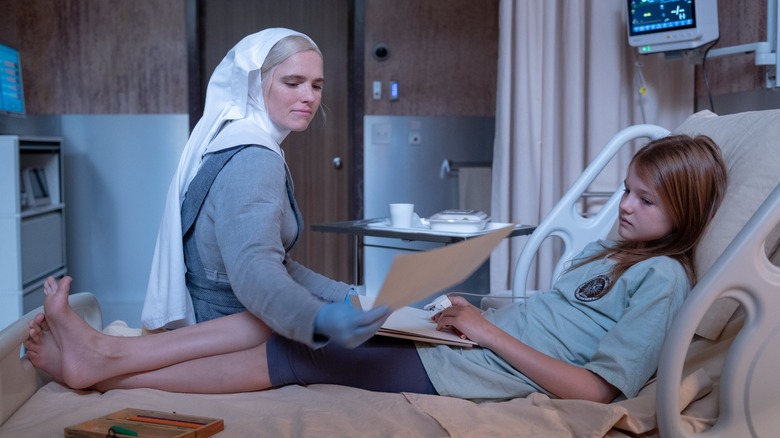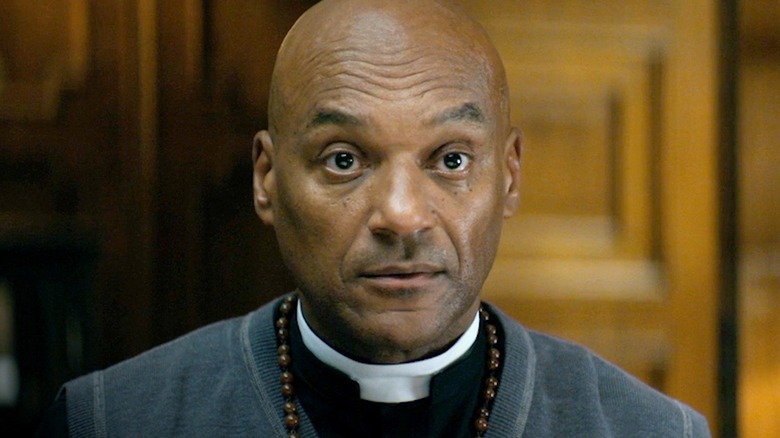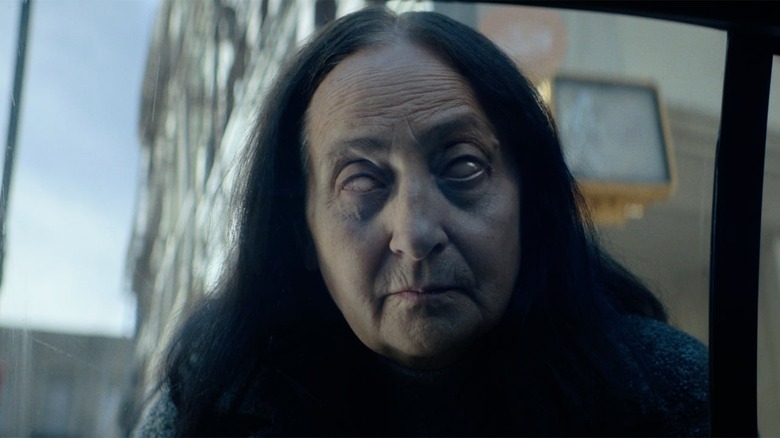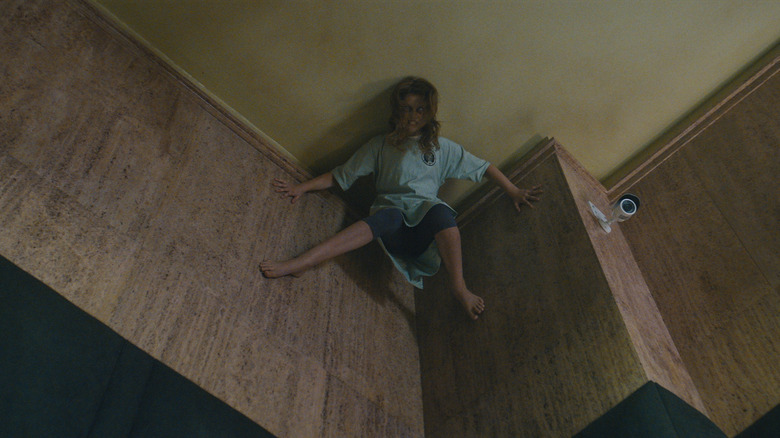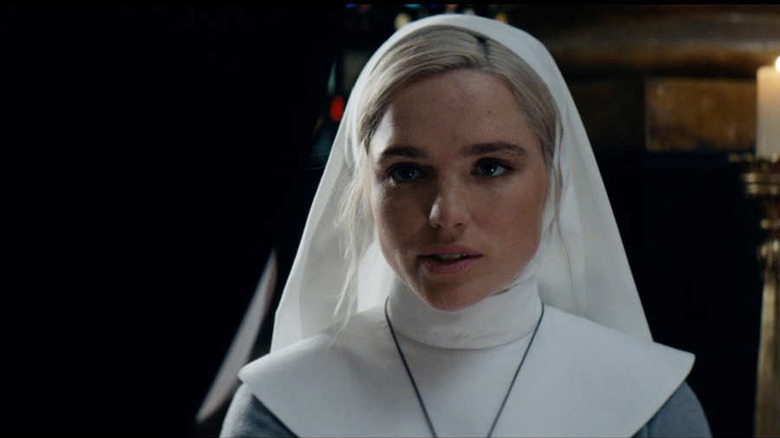The Ending Of Prey For The Devil Explained
Horror has been riding high for much of 2022, and that trend continues with "Prey for the Devil," a haunting exorcism film that hopes to continue the lineage of films like "The Exorcist," "The Omen" and "The Exorcism of Emily Rose" for a new generation.
The flick follows Sister Ann (Jacqueline Byers), a nun in training to conduct exorcisms, a rarity within the church; after a demon who once haunted her as a child comes to possess young Natalie (Posy Taylor), Sister Ann must come to the rescue of the girl.
Peppered with intriguing depictions of the Catholic Church and the dark process of exorcism, "Prey for the Devil" delivers solid scares and horrifying imagery. Among multiple twists and turns, the film builds to an epic battle between Sister Ann and the demonic force that has long haunted her.
Directed by Daniel Stamm (who seems to have a thing for such tales, following 2010's "The Last Exorcism"), the film presents a violent, chaotic conclusion that will leave some viewers with lingering questions. Below, the (spoiler-heavy) burning mysteries, and some dark answers.
The Devil or just a demon?
Sister Ann has been dealing with a demonic entity since she was a young girl; it possessed her mother, causing her to exhibit some disturbing behavior and violent actions, eventually leading to her death. So, when it suddenly returns in the form of Natalie, it becomes a key reason Ann joins the class taught by Father Quinn (Colin Salmon) on exorcisms, breaking gender norms within the church. However, it's never made exactly clear who or what the evil entity is.
The film's title could allude to the entity being simply "The Devil," but there's never really any sort of confirmation. Truthfully, Ann could simply be dealing with a demon looking to cause some terror and pain in her life — and boy, it sure does. The demon's disgusting, grotesque acts seem to indicate a severity to this presence, if not perhaps implying it might be the head demon himself.
Demonic motivations
Generally, the devil and other demons from hell are out to sew havoc and chaos in the world, but this film's evil entity has its sights set directly on Sister Ann. First, it tormented her as a child; now, it has seemingly taken up residence in little Natalie just to get closer to Ann. Even in the film's final moments, it relinquishes control of Natalie to possess Ann, which ultimately works for a short time. So, why is this thing so fixated on Sister Ann?
There's no definitive answer given in the film, but it's likely something along the lines of Ann being special and having been fated to be a force for good. There are signs and hints of this throughout the film, with Father Quinn and Dr. Peters (Virginia Madsen) telling Ann that her spirit is stronger than her body and that she can break free from this force through her inner strength. Ann's understanding of her sense of control in this battle against evil, and learning how to defy its power, is a big part of her personal arc as well, as she overcomes the inner demons stemming from her past.
Complicated traditions
Although viewers initially see co-ed classes on exorcism within the Catholic Church, the actual practice of exorcisms is limited to men. Women are excluded from learning the practice, nuns are blocked from certain records, and are largely unable to even listen in on classes or travel into the depths of the facility where possessed people are held in secrecy. This is mainly due to traditional roles within the church, resigning women to serve as simple nurses while the men perform exorcisms.
Sister Ann, however, is shown to be more of a rebel; she listens in on Father Quinn's classes, trains herself in unfriendly circumstances, and is ultimately uniquely qualified during a moment in need. By the end of the film, Sister Ann has made a sizable impact on the church, even being sent to the Vatican for further training and recognized as the first female exorcist within the church in numerous generations.
Sister Ann's secret
There's a moment where Father Quinn mentions that the devil and demons will go to any length to try and weaken someone's soul to take control, even revealing buried secrets. For example, after Sister Ann steps in to help with an exorcism that goes terribly wrong, Father Dante (Christian Navarro) notices a drawing that alludes to his sister becoming pregnant after being raped. For Ann, while she's helping Dante perform an exorcism on his sister, her secret becomes revealed when the demon starts making some pretty strong hints that she had a similar situation to Dante's sister.
Although Sister Ann wasn't raped, she did have an unplanned pregnancy when she was a teenager, eventually leading her to giving up the baby for adoption. It's an interesting moment that sheds some light on her backstory and inner demons, while also being a key moment that leads into the final act's biggest twists. Viewers eventually come to know even more about what exactly happened to her and the fate of that baby, but it's a strong mid-movie reveal that adds new stakes and meaning to everything that follows.
An unexpected connection
The biggest burning mystery in "Prey for the Devil" might be wondering what exactly this demonic entity has planned for Sister Ann, and why it chose now to come back. Once Ann starts putting the pieces together after being reminded about her giving up her daughter, however, things become clearer and Natalie's traumatic return to the facility is the definitive stamp of clarity that pulls it all together.
It's not too hard to figure out that Natalie is the baby that Ann gave up all those years ago, since the film offers context clues and Natalie uses a special rosary as an "invitation" to bring Ann back to the facility to face her. It's a reveal that adds more context to Ann's secret backstory, injecting more meaning into her ultimate return to the facility. This realization is the perfect kind of spark that "Devil" needed leading into its final act, making for a touching final moment between Ann and Natalie that goes against expectations.
What's up with the Vatican?
As Sister Ann delves a little deeper into the records of the Catholic Church's history of exorcisms, she begins to see a lot of cases that concluded unsuccessfully.
Most of the case files she comes across state that the afflicted died during an exorcism at the Vatican. Even when it's said that Natalie was going to be transferred to the Vatican, Ann doesn't seem excited at all by the news despite the Vatican being a respected, revered place within the Catholic religion. So, it needs to be asked, what's up with the Vatican?
At times, it feels more notorious than the demons, carrying an equally foreboding atmosphere. The history of fatal exorcisms is wildly consistent, to the point where the Vatican feels more like a hospice than an actual place of healing. This eerie reputation with exorcisms could stem from it simply just being the last straw when other places can't help any further. Perhaps that's why Ann is sent there at the end the film to help clean up its poor reputation. Regardless, if you're the one who's possessed and are forced to go to the Vatican, you can basically consider it a death sentence, according to this film.
A sacrificial lamb
In the film's final confrontation between the demon and Sister Ann, viewers are left wondering how Ann is going to save Natalie. After all, this demon has shown its horrifying power, and now looks stronger than ever. However, with a perspective of her own power and realizing that Natalie is her daughter, Ann has a newfound confidence that allows her to make a drastic choice to save the child.
Ann basically pulls the same maneuver that Father Damien did in "The Exorcist," getting the demon to possess her instead of Natalie. It's a very intense, dark moment since the visuals of this possession are skin-crawling. The way the demon makes Ann's body contort in disgusting ways and her eyes fill up with black nothingness is chilling, one of the darkest moments of the finale. To save Natalie, Ann is willing to give the demon what it wants, but her newfound understanding makes this moment act as a seemingly grim decision that plays into her personal arc.
Defeating the demon with holy water
After saving Natalie by getting the demon to possess her instead, Sister Ann is stuck in quite a predicament. Her body has become nearly completely possessed by the demon, and her sense of control is slipping away. She's even on the verge of hurting Dante and Natalie under the demon's control. Yet, Ann is able to regain her control by remembering wise words from Father Quinn and Dr. Peters.
Their words of encouragement, highlighting the importance of Ann's good-hearted soul, drive Ann to take back control in her fight against vicious evil. With the nun once again in control of her body, she falls into a fountain of holy water, cleansing her body and expunging the demon. Although she nearly drowns in the process, Ann risks it all to defeat the demon, and it's a powerful moment in her personal story. While it might not fully kill the demon, this moment allows Ann to know that she can defeat this demon the next time it rears its ugly head.
The real first female exorcist
Throughout the film, Sister Ann is portrayed as a revolutionary within the church, the only nun learning how to perform exorcisms. It's something that initially earns her ridicule and doubt, but eventually a level of respect in how she's able to cleanse Natalie of the demon and save her life. Her efforts even earn her a place at the Vatican and the title of being the first female exorcist within the church amongst her peers. However, it's said that Ann is not the first female exorcist.
In a conversation between Ann and Father Quinn, it is mentioned that St. Catherine of Sienna was actually the first female exorcist, and has a strong legacy within the practice. However, as Ann says, she's still the first female exorcist in over a century. So, she's made a strong cultural impact, albeit one with a precedent.
A demon that's not down and out
Sister Ann quite literally goes to hell and back to stop this demon; fortunately, she's able to gain control long enough to cleanse herself and survive the whole ordeal. So, this all must've killed whatever this evil thing is, right? Well, not exactly.
Ann entire fountain of holy water apparently isn't enough to completely kill this thing, as Ann quickly finds out that she hasn't escaped the demon just yet. While leaving the facility to start her training at the Vatican, Ann finds herself surrounded by the demon and is forced to bring out her cross to make a stand. Even though Ann hasn't escaped the grasp of this evil force, she's much more prepared now and can easily put up a more substantial fight, perhaps even one big enough for a follow-up film.
Will there be a sequel?
While no sequel has been announced for "Prey for the Devil," the film's ending does spark some possibilities. In fact, there could be some interesting directions it might take to show another story within this world.
The film's ending depicts Sister Ann as not only going to the Vatican to gain more knowledge on exorcisms, but also still haunted by the demon. So, a sequel story of Ann going to the Vatican to rid herself of this demon could continue her story and perhaps get to the root of the Vatican being a death sentence for exorcisms. Also, if the next film didn't focus on Ann, there could be some interesting story ideas that could work. Perhaps there could be a story focused on Dante, a new student of Father Quinn, or maybe even a prequel focusing on St. Catherine of Sienna, the true first female exorcist of the church. Either way, there appears to be more stories that could be told in this universe.
Did Sister Ann create some real change in the church?
The impact Sister Ann has in her journey to understanding exorcisms can be felt throughout the entire film. Her involvement in saving Natalie causes many higher-ups to re-evaluate their stance on women, she gets sent to the Vatican to gain more knowledge, and perhaps change more lives. But did her efforts truly change the culture?
"Prey for the Devil" isn't based on true events, and Ann isn't based on a real person. But in the world of the film, perhaps Ann's story will shake the foundation and thinking within those looking to pursue knowledge in how to perform exorcisms. Ann has gained respect from her peers for her actions, and Father Quinn's acknowledgement of St. Catherine of Sienna in his final talk with Ann made it clear she has left a meaningful impact. Ann, it seems, made a difference — even if she had to travel to hell and back to do it.
